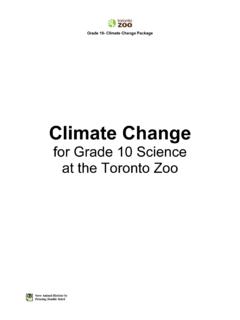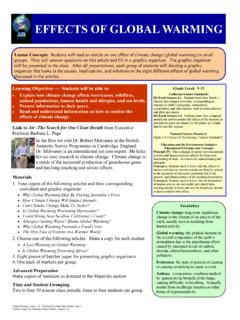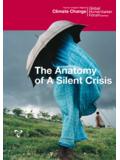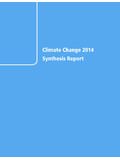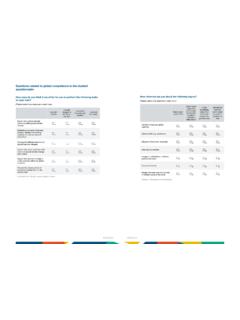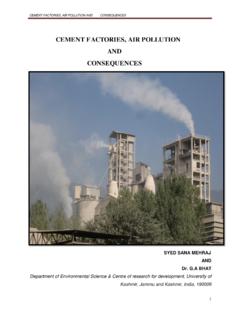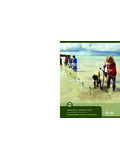Transcription of Preliminary study on the drivers of deforestation and ...
1 Preliminary study on the drivers of deforestation & potential for REDD+ in ZambiaRepublic of ZambiaMinistry of Lands,Natural Resources and Environmental Protection2012 Preliminary study on the drivers of deforestation & potential for REDD+ in ZambiaConsultancy report prepared by School of Natural Resources, Copperbelt University, on behalf of Forestry Department and FAO under the national UN-REDD+ Programme Contacts School of Natural Resources, Copperbelt University, Box 21692 Kitwe, Zambia. Telephone: +260 212 230923. Email: Consultants Name Email Royd Vinya (PhD) Exhildah C. Kasumu (PhD) Stephen Syampungani (PhD) Concilia Monde Robby Kasubika Citation: Vinya, R., Syampungani, S.
2 , Kasumu, , Monde, C. & Kasubika, R. (2011). Preliminary study on the drivers of deforestation and Potential for REDD+ in Zambia. A consultancy report prepared for Forestry Department and FAO under the national UN-REDD+ Programme Ministry of Lands & Natural Resources. Lusaka, Zambia. The designations employed and the presentation of material in this information product do not imply the expression of any opinion whatsoever on the part of the Food and Agriculture Organization of the United Nations (FAO) concerning the legal or development status of any country, territory, city or area or of its authorities, or concerning the delimitation of its frontiers or boundaries. The mention of specific companies or products of manufacturers, whether or not these have been patented, does not imply that these have been endorsed or recommended by FAO in preference to others of a similar nature that are not views expressed in this information product are those of the author(s) and do not necessarily reflect the views of rights reserved.
3 FAO encourages reproduction and dissemination of material in this information product. Non-commercial uses will be authorized free of charge, upon request. Reproduction for resale or other commercial purposes, including educational purposes, may incur fees. Applications for permission to reproduce or disseminate FAO copyright materials, and all queries concerning rights and licences, should be addressed by e-mail to or to the Chief, Publishing Policy and Support Branch, Office of Knowledge Exchange, Research and Extension, FAO, Viale delle Terme di Caracalla, 00153 Rome, Italy. FAO 2012iii EXECUTIVE SUMMARY 1. This study sought to answer the question: what drives deforestation and what is the potential for REDD+ in Zambia? Since deforestation and poor forest management reduce carbon storage in tropical forests, there has been increasing pressure to minimize carbon stock losses.
4 The objectives of this study were to provide a Preliminary understanding regarding drivers of deforestation and the potential for REDD+in Zambia; to assess to what extent our current consumption, production and development patterns affect deforestation levels, as well as assessing the potential impact of future shifts in these patterns; to draw conclusions as to which actions/trends would probably have the most serious consequences in terms of additional deforestation , and analyse how these could be reduced in future. The final aim was to outline the potential for REDD+ in these circumstances. 2. In order to address these stated objectives, we used an interdisciplinary data gathering approach, integrating literature search, policy level consultancy, community level consultations, stakeholder interviews, courtesy calls and field visits.
5 3. According to this Preliminary study , deforestation hotspots in Zambia are mainly located along the highly urbanized rail link running from Southern to Copperbelt provinces. New hotspots are also rapidly emerging in the less urbanized provinces. 4. This Preliminary study has revealed that forest cover loss in deforestation hotspots has been on an upward trend since the late 1980s. 5. The direct drivers of deforestation in Zambia can be grouped into four categories. These are: x Agricultural expansion x Infrastructure development x Wood extraction x Fires iv 6. The ultimate drivers of forest cover loss are agricultural expansion, charcoal production, fuelwood collection, wood harvesting, settlements, fires, urbanization, industrialization, urban expansion and livestock grazing.
6 The underlying drivers are high poverty levels, low employment opportunities, brick-making, tobacco curing, insecure tenure rights, low institutional capacity (poor funding, low staffing levels, lack of reliable transport for monitoring) and lack of synergy among policies and legislation. 7. The challenges of reducing deforestation in Zambia include improving linkages and coordination between relevant institutions in natural resource management (NRM); regularly updating information on the national status of forests; enhancing complementarity of relevant policies and institutions; making NRM policies supportive and inclusive; developing a close relationship between infrastructure development and forest conservation; eliminating or minimizing political interference in forest resource management; promoting secure land tenure systems and developing clear policies and guidelines that effectively address issues of benefit-sharing mechanisms.
7 8. Viable options available for halting forest cover loss in Zambia may include enhancing soil quality and erosion control, afforestation, woodland regeneration and agroforestry as conservation strategies aimed at increasing carbon stocks in degraded sites. 9. Current high levels of deforestation (between 250 000 and 300 000 ha/year) in Zambia mean there is high potential for Zambia s participation under REDD+, since degraded sites may still be managed for carbon sequestration through coppice or regeneration management. The capacity of miombo woodlands to recover almost completely following clearing for either charcoal production or slash-and-burn agriculture, offers very high potential for local communities to participate in carbon trading under REDD+ financing mechanisms.
8 10. In conclusion, deforestation is a complex matter, with many drivers operating at varying levels. The major challenge is therefore to reconcile the need to improve people s livelihoods with the urgency of achieving sustainable forest resource management. REDD+ offers an opportunity for rural dwellers to trade in forest ecosystem services that do not lead to loss in forest cover. v TABLE OF CONTENTS EXECUTIVE SUMMARY .. III TABLE OF CONTENTS .. V LIST OF TABLES .. VII LIST OF FIGURES .. VII ACRONYMS/ ABBREVIATIONS .. VIII INTRODUCTION .. 1 VEGETATION TYPES OF ZAMBIA .. 2 MANAGEMENT OF FOREST RESOURCES .. 3 PAST STRATEGIES TO ENHANCE SUSTAINABLE FOREST MANAGEMENT .. 3 METHODOLOGY .. 6 SITE SELECTION .. 6 METHODOLOGY .. 6 DATA COLLECTION .. 6 DATA ANALYSIS .. 7 FINDINGS .. 8 deforestation HOTSPOTS IN ZAMBIA.
9 8 HISTORIC, CURRENT & FUTURE TRENDS OF deforestation AND FOREST DEGRADATION .. 9 drivers OF deforestation AND THEIR 13 LEGISLATIVE AND POLICY FRAMEWORK .. 15 INSTITUTIONAL FACTORS .. 16 ENVIRONMENTAL FACTORS AND THEIR LINK TO deforestation .. 17 SOCIO-ECONOMIC drivers AND CAUSES OF deforestation .. 21 INFRASTRUCTURE DEVELOPMENT .. 25 CHALLENGES FOR REDUCING drivers OF deforestation .. 27 POOR LINKAGE AND COORDINATION WITH OTHER RELEVANT INSTITUTIONS .. 27 UNAVAILABILITY OF UPDATED INFORMATION ON THE NATIONAL STATUS OF FORESTS .. 27 LACK OF COMPLEMENTARITY OF RELEVANT POLICIES AND INSTITUTIONS .. 27 LACK OF SUPPORTIVE AND INCLUSIVE NATURAL POLICIES .. 27 INFRASTRUCTURE DEVELOPMENT AND FOREST CONSERVATION .. 28 POLITICAL INTERFERENCE .. 28 vi INSECURE LAND TENURE SYSTEM .. 28 LACK OF BENEFIT-SHARING MECHANISM.
10 29 OPTIONS AVAILABLE TO EFFECTIVELY REDUCE IMPACTS ON FOREST RESOURCES .. 29 REGENERATION AND COPPICE ENHANCEMENT MANAGEMENT .. 30 AGROFORESTRY, SOIL MANAGEMENT AND CLIMATE CHANGE MITIGATION .. 30 FIRE MANAGEMENT .. 32 ALTERNATIVE ENERGY SOURCES AND IMPROVED CHARCOAL USE AND PRODUCTION METHODS .. 33 ALTERNATIVE LIVELIHOOD SYSTEMS .. 34 IMPROVING STAFFING LEVELS AND COLLABORATION WITH LOCAL COMMUNITY MEMBERS .. 34 POTENTIAL FOR REDD+ IN ZAMBIA .. 35 WOODLAND RECOVERY, PRODUCTIVITY AND POTENTIAL FOR REDD+ PROJECTS .. 36 MECHANISMS OF CARBON STORAGE AND LOSS IN WOODLANDS .. 38 METHODOLOGIES AND TOOLS FOR ESTIMATING deforestation TRENDS 39 CONCLUSIONS AND RECOMMENDATIONS .. 42 REFERENCES .. 43 GLOSSARY .. 50 APPENDICES .. 51 vii LIST OF TABLES Table 1: Major vegetation formation of Zambia .. 2 Table 2: provinces and districts involved in the study .










